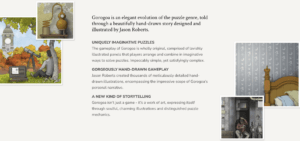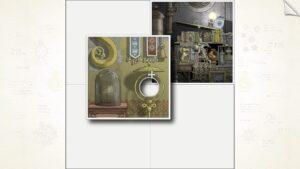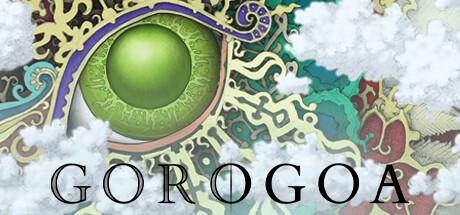Gorogoa is a puzzle game created by a one-man studio, Jason Roberts. It’s available on many platforms, including Steam, Apple, Android, and consoles. The target audience is broadly puzzle game enjoyers, though more specifically I would guess it is no younger than teens in order to be able to quickly form a mental model of the not-entirely-intuitive mechanics of the puzzle, as well as be able to appreciate the not-immediately-attention-grabbing but definitely super unique hand-drawn art style.
Compared to some more abstract puzzle games like Flow (the game where you connect dots with lines), Gorogoa is very clearly also a narrative game. However, compared to some other puzzle games that are built around a narrative like Portal 2 or Superliminal, those games feel like you—the player—are trapped in an environment and trying to find the way out through solving puzzles (perhaps helped by the fact that they are first person), whereas Gorogoa feels much more like flipping the pages in a visual novel and solving puzzles is the way to turn the next page.

Pictured: Gorogoa’s website describing Jason’s own take on what type of a game it is.
The mechanics of the puzzle itself is rather hard to describe, as there are very few similar games to compare it to—you really have to play it in order for the game to guide you in building a mental model as you play. The player is thrown straight into this bizarre world, so before the player has an understanding of how the world works, the primary way the game teaches the player is trial and error. To ease the learning curve, the first few chapters of the game feel quite similar to a 2D point-and-click adventure game, so the player naturally has the instinct to click things. This is aided by how there are very few objects available to click, guaranteeing the player can progress the story without having yet understood what exactly they did.

This makes for quite an unusual interaction loop: The player begins by using some small amount of prior experience with point-and-click adventure games to decide what to do, but mainly the decision is random. The action is taken—very simply, just click. Some set of rules is applied, which the player has no understanding of yet. Feedback is in the form of whether the story progresses or not. And finally, at least in my case, the player… does not learn much. Since the decision was made randomly, it is only possible to learn if the decision was good, and it is impossible to learn why the decision was good. I felt like a machine learning model that could do things for rewards but have no understanding of the world. It took me several of these loops before I had large enough of a sample to start generalizing and guessing at how this world actually works and start forming a mental model.
This is aided by how the formal elements of the game are revealed to the player over time. Since the game has no text but does have illustrations, I was only able to learn of the objectives and outcomes of the game (to collect these fruit thingys) after getting the first one. Procedures and boundaries are learned through trial and error as described above. Even though I haven’t finished the game yet, I think it’s the case that there are no logically coherent rules, which I find kind of unsatisfying and frustrating. In a game like Portal 2 or Superliminal, you are introduced to the rules and mechanics very clearly, and the rest of the game revolves around creative applications of your portal gun or object scaling. In Gorogoa, there is the central mechanic of dragging frames onto each other, but what happens after that is anyone’s guess. In some sense, the game is purely a game of experiencing the designer’s narrative, with no expression possible like there is to some extent in Portal 2 or Superliminal.




